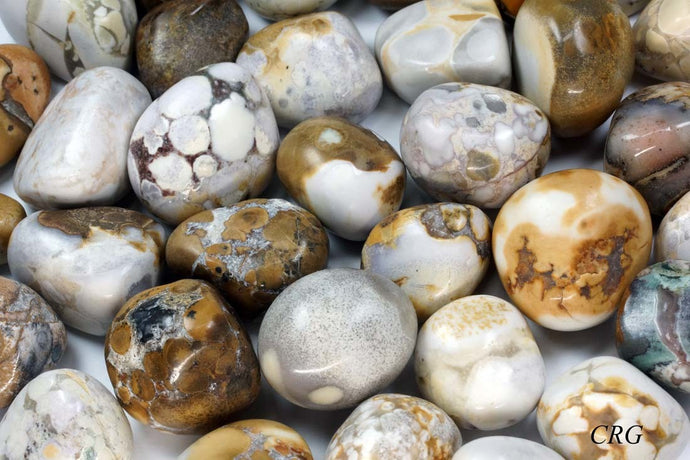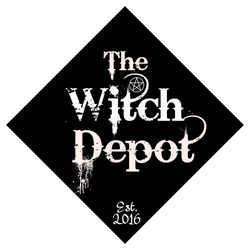
Conglomerate Jasper, Tumbled
Regular price
$3.00
Sale
The unique artistry of Jasper is that of Nature itself - golden sunshine, a nighttime sky, poppy fields or a deep green forest, desert sands, the undulating ocean, red rock canyons, sweeping mountains. Each stone is a masterpiece of the Creator, bold and primitive in style, solid and earthy in form, with a warm, harmonious energy that resonates with the primal self.
An elemental Earth stone, Jasper’s frequency is slow and constant, aligned with the electromagnetic energies of the planet. It enables one to be more present in the physical body and conscious of Nature and one’s surroundings. It encourages one to celebrate moments of isolation to absorb, reflect, and connect with these energies and enkindles an awareness of the spiritual connection we hold with all living things. [Simmons, XXIX, 215-219][Melody, 344-345]
Known as the “Supreme Nurturer,” Jasper is a stone of grounding and stability, providing comfort and security, strength and healing. Its presence balances the aura to a level of wholeness and peace, and acts as a reminder that one is not here on the physical plane simply for oneself, but to bring joy and substance to others. [Simmons, 215-219][Melody, 344-345][Hall, 154-155][Margherita, 505-507]
Historically, Jasper is traceable to all ancient peoples and civilizations. Worn by shamans, priests and kings, it was considered sacred and a powerful protection stone, for both the physical world and in the spiritual realm. Amulets of Jasper were carved by the Egyptians with symbols and inscriptions from the Book of the Dead and buried with mummified remains for safe passage in the after life. It was highly utilized in many cultures for engraving cylinder seals, signet rings, and special talismans depicting astrological and religious images. It was the twelfth stone in the Breastplate of the Jewish High Priest, and the apostle Peter is supposed to have derived his name from Jasper, the rock upon which Christ would build his church. To the medieval world and the Native Americans, Jasper was “the rain bringer” and highly regarded as a stone for dowsing. [Mella, 87-88][Melody, 344-345][Kunz, 90, 122, 226-229, 276][Fernie, 199]
Jasper is a dense, opaque, microcrystalline variety of Quartz. Fibrous and grainy varieties of Quartz are often grouped together and referred to as Chalcedony, though Jasper’s microcrystals are laid out in large, sugar-like grains rather than the fibrous layers of Chalcedony or Agate. It occurs in nodules or as fillings in fissures and may be found all over the world, in nearly every color. Jasper is colored by oxides of iron and known for its deep earthy tones of red, yellow, brown and green, sometimes in shades of blue or purple, and displays wonderful contrasts in its banding, inclusions, “pictures,” and small circular patterns. Its name is derived from the Greek iaspis, meaning “agate,” the Assyrian ashpu, and the Hebrew jashpeh. [www.mindat.org][Simmons, 215][Lecouteux, 177][Megemont, 100][Fernie, 173]
There is a wide variety of Jaspers, characterized by color, form, and similarities to places or animals found in nature. Many are named for the regions where they are mined; others are named by those who discovered them.
Jasper strengthens one’s connection to the Earth and the spiritual wisdom and sacredness of life that exists in nature. It encourages one to celebrate moments of beauty in the ordinary and the extraordinary, and to find harmony within the self, and with others. Through meditation and dream work, Jasper can provide a connection with Earth’s ancient past and allows one to retrieve spiritual knowledge for use in the present to help heal humanity and the planet. [Simmons, 215-219]
Jasper conglomerate is an informal term for a very distinctive Paleoproterozoic quartz and jasper pebble conglomerate that occurs within the middle part of the Lorrain Formation of the Cobalt Group of the Huronian Supergroup. It is also known by other names including pebble jasper conglomerate, St. Joseph Island puddingstone, Drummond Island puddingstone, Michigan puddingstone. The jasper conglomerate occurs on St. Joseph Island and the St. Mary's River area north and northwest of the Bruce Mines of Northern Ontario, about 65 kilometres (40 mi) east of Sault Ste. Marie. This conglomerate consisted originally of gravelly sands and sandy gravels composed of subrounded pebbles of red jasper, white quartzite, semi-transparent quartz, and black chert, with coarse-grained sand matrix. Typically it contains between about 30% to as much as 90% pebbles. It has been cemented and partially metamorphosed into a quartzitic conglomerate. The beds of jasper conglomerates fill erosional troughs and channels of what are interpreted to be either alluvial fan or braided river deposits of the Lorrain Formation. These deposits are interpreted to represent nonglacial deposits that immediately postdate the Makganyene glaciation.
A sample of jasper conglomerate rock from St. Joseph Island, Ontario.
Because of its distinctive nature, pebble- to boulder-size fragments of jasper conglomerate can be recognized as glacial erratics in Pleistocene glacial tills and drift within large parts of the glaciated Midwestern United States. Fragments of jasper conglomerate were eroded by continental ice-sheets from Northern Ontario and spread across all of Michigan and as far south as Ohio and Kentucky during repeated glacial advances and retreats. For example, pebble to boulder-size fragments of jasper conglomerate are quite common on Drummond Island, Michigan where it is called Drummond Island puddingstone.
